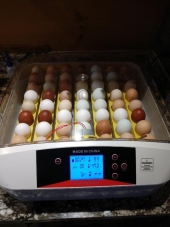
 4
4




![Filename: 2019-02-22.png
Description: Heating cycles. Red dots are heat lamp on, black dots are heat lamp off. [Thumbnail for 2019-02-22.png]](/t/103276/a/72483/2019-02-22.png)
 4
4




Sometimes the answer is nothing





Sometimes the answer is nothing

 3
3




A build too cool to miss:Mike's GreenhouseA great example:Joseph's Garden
All the soil info you'll ever need:
Redhawk's excellent soil-building series





 1
1




Standing on the shoulders of giants. Giants with dirt under their nails
 1
1




Tj Jefferson wrote:Super cool project! Are the eggs rotated or not? We have a friend with tons of guineas, and they are tricky to hatch, but sometimes they find eggs before the black snakes get them, I am interested if this works, we rotted a whole clutch last year in a cheap incubator which made me sad.
Thanks for posting this!
wayne fajkus wrote:Store bought incubators are relatively inexpensive. The only "tweek" i have done is zero'ing in the temps on them. I insert a meat thermometer to verify the actual temp vs the incubators displayed temp, then start adjusting the temp setting until the meat thermometer shows the temp i want. I got a much higher success rate after doing this. Like a 100% success rate after this, compared to 60% or less before.




we are here to learn




-Clucky Chucky

|
I just had the craziest dream. This tiny ad was in it.
Homestead Pigs Course
https://permies.com/wiki/365748/Homestead-Pigs
|






